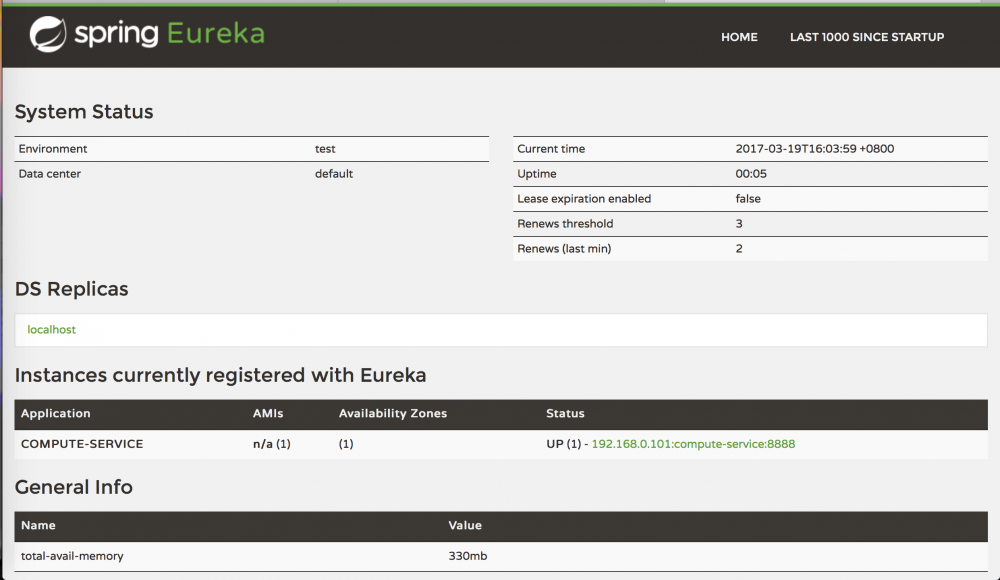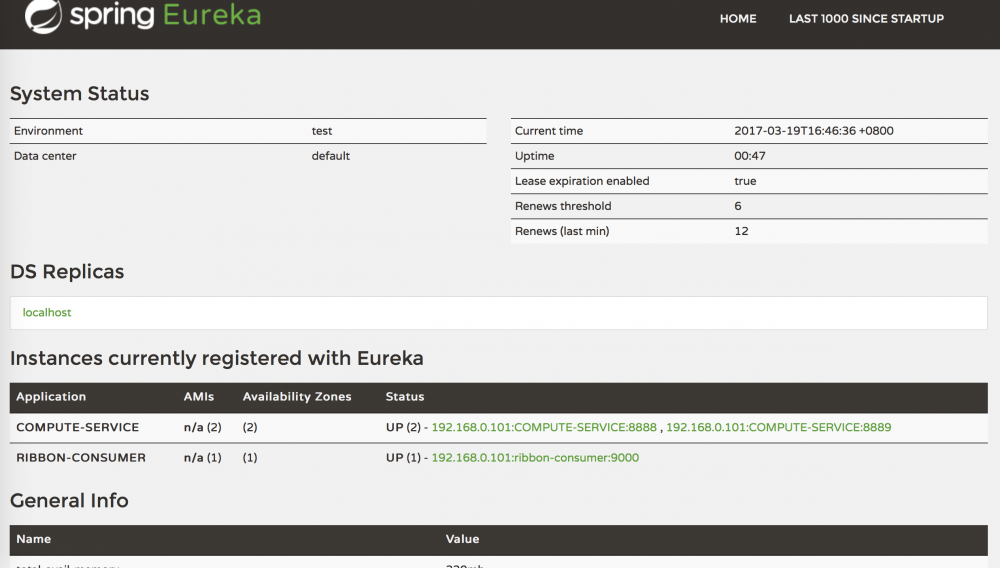服务发现组件Eureka
这篇文章记录了我学习Spring Cloud中Eureka组件的过程和例子。
引子
看完《微服务设计》后,算是补上了自己在服务化这块的理论知识,在业界,一般有两种微服务的实践方法:基于dubbo的微服务架构、基于Spring Cloud的微服务架构。从概念上来讲,Dubbo和Spring Cloud并不能放在一起对比,因为Dubbo仅仅是一个RPC框架,实现Java程序的远程调用,实施服务化的中间件则需要自己开发;而Spring Cloud则是实施微服务的一系列套件,包括:服务注册与发现、断路器、服务状态监控、配置管理、智能路由、一次性令牌、全局锁、分布式会话管理、集群状态管理等。
在有赞,我们基于Dubbo实施服务化,刚开始是基于ZooKeeper进行服务注册与发现,现在已经转成使用Etcd。我这次学习Spring Cloud,则是想成体系得学习下微服务架构的实现,也许能够对基于Dubbo实施微服务架构有所借鉴。
Spring Cloud下有很多工程:
- Spring Cloud Config:依靠git仓库实现的中心化配置管理。配置资源可以映射到Spring的不同开发环境中,但是也可以使用在非Spring应用中。
- Spring Cloud Netflix:不同的Netflix OSS组件的集合:Eureka、Hystrix、Zuul、Archaius等。
- Spring Cloud Bus:事件总线,利用分布式消息将多个服务连接起来。非常适合在集群中传播状态的改变事件(例如:配置变更事件)
- Spring Cloud Consul:服务发现和配置管理,由Hashicorp团队开发。
我决定先从Spring Cloud Netflix看起,它提供了如下的功能特性:
- 服务发现:Eureka-server实例作为服务提供者,可以注册到服务注册中心,Eureka客户端可以通过Spring管理的bean发现实例;
- 服务发现:嵌套式的Eureka服务可以通过声明式的Java配置文件创建;
- 断路器:利用注解,可以创建一个简单的Hystrix客户端;
- 断路器:通过Java配置文件可以创建内嵌的Hystrix控制面板;
- 声明式REST客户端:使用Feign可以创建声明式、模板化的HTTP客户端;
- 客户端负载均衡器:Ribbon
- 路由器和过滤器:Zuul可以在微服务架构中提供路由功能、身份验证、服务迁移、金丝雀发布等功能。
本文计划利用Eureka实现一个简答的服务注册于发现的例子,需要创建三个角色:服务注册中心、服务提供者、服务消费者。
实践
服务注册中心
在IDEA中创建一个Spring Cloud工程,引入Eureka-Server包,pom文件整体如下:
<?xml version="1.0" encoding="UTF-8"?>
<project xmlns="http://maven.apache.org/POM/4.0.0"
xmlns:xsi="http://www.w3.org/2001/XMLSchema-instance"
xsi:schemaLocation="http://maven.apache.org/POM/4.0.0 http://maven.apache.org/xsd/maven-4.0.0.xsd">
<modelVersion>4.0.0</modelVersion>
<groupId>org.example.springcloud</groupId>
<artifactId>service-register</artifactId>
<version>1.0-SNAPSHOT</version>
<!-- spring boot的parent 配置文件,有大部分spring boot需要用的Jar包 -->
<parent>
<groupId>org.springframework.boot</groupId>
<artifactId>spring-boot-starter-parent</artifactId>
<version>1.5.1.RELEASE</version>
</parent>
<properties>
<project.build.sourceEncoding>UTF-8</project.build.sourceEncoding>
<java.version>1.8</java.version>
</properties>
<!-- spring boot的maven打包插件 -->
<build>
<plugins>
<plugin>
<groupId>org.springframework.boot</groupId>
<artifactId>spring-boot-maven-plugin</artifactId>
</plugin>
</plugins>
</build>
<dependencies>
<!-- eureka-server -->
<dependency>
<groupId>org.springframework.cloud</groupId>
<artifactId>spring-cloud-starter-eureka-server</artifactId>
</dependency>
<!-- spring boot test-->
<dependency>
<groupId>org.springframework.boot</groupId>
<artifactId>spring-boot-starter-test</artifactId>
<scope>test</scope>
</dependency>
</dependencies>
<dependencyManagement>
<dependencies>
<dependency>
<groupId>org.springframework.cloud</groupId>
<artifactId>spring-cloud-dependencies</artifactId>
<version>Camden.SR5</version>
<type>pom</type>
<scope>import</scope>
</dependency>
</dependencies>
</dependencyManagement>
</project>
在src/main/java包下创建一个名为hello的包,然后创建 EurekaServiceRegisterApplication 类,并用@EnableEurekaServer和@SpringBootApplication两个注解修饰,后者是Spring Boot应用都需要用的,这里不作过多解释;@EnableEurekaServer注解的作用是触发Spring Boot的自动配置机制,由于我们之前在pom文件中导入了eureka-server,spring boot会在容器中创建对应的bean。EurekaServiceRegisterApplication的代码如下:
package hello;
import org.springframework.boot.SpringApplication;
import org.springframework.boot.autoconfigure.SpringBootApplication;
import org.springframework.cloud.netflix.eureka.server.EnableEurekaServer;
/**
* Created by IntelliJ IDEA.
* User: duqi
* Date: 2017/3/2
* Time: 20:02
*/
@EnableEurekaServer //通过@EnableEurekaServer启动一个服务注册中心给其他应用使用
@SpringBootApplication
public class EurekaServiceRegisterApplication {
public static void main(String[] args) {
SpringApplication.run(EurekaServiceRegisterApplication.class, args);
}
}
在application.properties中还需要增加如下配置,才能创建一个真正可以使用的服务注册中心。
#注册服务的端口号
server.port=8761
#是否需要注册到注册中心,因为该项目本身作为服务注册中心,所以为false
eureka.client.register-with-eureka=false
#是否需要从注册中心获取服务列表,原因同上,为false
eureka.client.fetch-registry=false
#注册服务器的地址:服务提供者和服务消费者都要依赖这个地址
eureka.client.service-url.defaultZone=http://localhost:${server.port}/eureka
logging.level.com.netflix.eureka=OFF
logging.level.com.netflix.discovery=OFF
启动注册服务,并访问: http://localhost:8761 ,就可以看到如下界面。

服务提供者
创建一个Spring Boot工程,代表服务提供者,该服务提供者会暴露一个加法服务,接受客户端传来的加数和被加数,并返回两者的和。
工程的pom文件内容如下:
<?xml version="1.0" encoding="UTF-8"?>
<project xmlns="http://maven.apache.org/POM/4.0.0"
xmlns:xsi="http://www.w3.org/2001/XMLSchema-instance"
xsi:schemaLocation="http://maven.apache.org/POM/4.0.0 http://maven.apache.org/xsd/maven-4.0.0.xsd">
<modelVersion>4.0.0</modelVersion>
<groupId>org.example.springcloud</groupId>
<artifactId>service-client</artifactId>
<version>1.0-SNAPSHOT</version>
<parent>
<groupId>org.springframework.boot</groupId>
<artifactId>spring-boot-starter-parent</artifactId>
<version>1.5.1.RELEASE</version>
<relativePath/>
</parent>
<properties>
<project.build.sourceEncoding>UTF-8</project.build.sourceEncoding>
<java.version>1.8</java.version>
</properties>
<build>
<plugins>
<plugin>
<groupId>org.springframework.boot</groupId>
<artifactId>spring-boot-maven-plugin</artifactId>
</plugin>
</plugins>
</build>
<dependencies>
<dependency>
<groupId>org.springframework.cloud</groupId>
<artifactId>spring-cloud-starter-eureka</artifactId>
</dependency>
<dependency>
<groupId>org.springframework.boot</groupId>
<artifactId>spring-boot-starter-test</artifactId>
<scope>test</scope>
</dependency>
<dependency>
<groupId>org.springframework.cloud</groupId>
<artifactId>spring-cloud-starter-eureka-server</artifactId>
<scope>test</scope>
</dependency>
</dependencies>
<dependencyManagement>
<dependencies>
<dependency>
<groupId>org.springframework.cloud</groupId>
<artifactId>spring-cloud-dependencies</artifactId>
<version>Camden.SR5</version>
<type>pom</type>
<scope>import</scope>
</dependency>
</dependencies>
</dependencyManagement>
</project>
其中的关键在于spring-cloud-starter-eureka这个Jar包,其中包含了eureka的客户端实现。
在src/main/java/hello下创建工程的主类EurekaServerProducerApplication,使用@EnableDiscoveryClient注解修饰,该注解在服务启动的时候,可以触发服务注册的过程,向配置文件中指定的服务注册中心(Eureka-Server)的地址注册自己提供的服务。EurekaServerProducerApplication的源码如下:
package hello;
import org.springframework.boot.SpringApplication;
import org.springframework.boot.autoconfigure.SpringBootApplication;
import org.springframework.cloud.client.discovery.EnableDiscoveryClient;
/**
* Created by IntelliJ IDEA.
* User: duqi
* Date: 2017/3/2
* Time: 20:34
*/
@EnableDiscoveryClient
@SpringBootApplication
public class EurekaServerProducerApplication {
public static void main(String[] args) {
SpringApplication.run(EurekaServerProducerApplication.class, args);
}
}
配置文件的内容如下:
#服务提供者的名字 spring.application.name=compute-service #服务提供者的端口号 server.port=8888 #服务注册中心的地址 eureka.client.serviceUrl.defaultZone=http://localhost:8761/eureka/
服务提供者的基本框架搭好后,需要实现服务的具体内容,在ServiceInstanceRestController类中实现,它的具体代码如下:
package hello;
import org.slf4j.Logger;
import org.slf4j.LoggerFactory;
import org.springframework.beans.factory.annotation.Autowired;
import org.springframework.cloud.client.ServiceInstance;
import org.springframework.cloud.client.discovery.DiscoveryClient;
import org.springframework.web.bind.annotation.GetMapping;
import org.springframework.web.bind.annotation.RequestParam;
import org.springframework.web.bind.annotation.RestController;
/**
* Created by IntelliJ IDEA.
* User: duqi
* Date: 2017/3/2
* Time: 20:36
*/
@RestController
public class ServiceInstanceRestController {
private static final Logger logger = LoggerFactory.getLogger(ServiceInstanceRestController.class);
@Autowired
private DiscoveryClient discoveryClient; //服务发现客户端
@GetMapping(value = "/add")
public Integer add(@RequestParam Integer a, @RequestParam Integer b) {
ServiceInstance instance = discoveryClient.getLocalServiceInstance();
Integer r = a + b;
logger.info("/add, host:" + instance.getHost() + ", service_id:" + instance.getServiceId() + ", result:" + r);
return r;
}
}
先启动服务注册中心的工程,然后再启动服务提供者,在访问: localhost:8761 ,如下图所示,服务提供者已经注册到服务注册中心啦。

在Spring Cloud Netflix中,使用Ribbon实现客户端负载均衡,使用Feign实现声明式HTTP客户端调用——即写得像本地函数调用一样。
服务消费者-Ribbon
创建一个Spring boot工程,引入ribbon和eureka,pom文件内容如下:
<?xml version="1.0" encoding="UTF-8"?>
<project xmlns="http://maven.apache.org/POM/4.0.0"
xmlns:xsi="http://www.w3.org/2001/XMLSchema-instance"
xsi:schemaLocation="http://maven.apache.org/POM/4.0.0 http://maven.apache.org/xsd/maven-4.0.0.xsd">
<modelVersion>4.0.0</modelVersion>
<groupId>org.example.springcloud</groupId>
<artifactId>serviceconsumer</artifactId>
<version>1.0-SNAPSHOT</version>
<parent>
<groupId>org.springframework.boot</groupId>
<artifactId>spring-boot-starter-parent</artifactId>
<version>1.5.1.RELEASE</version>
</parent>
<properties>
<project.build.sourceEncoding>UTF-8</project.build.sourceEncoding>
<java.version>1.8</java.version>
</properties>
<build>
<plugins>
<plugin>
<groupId>org.springframework.boot</groupId>
<artifactId>spring-boot-maven-plugin</artifactId>
</plugin>
</plugins>
</build>
<dependencies>
<!-- 客户端负载均衡 -->
<dependency>
<groupId>org.springframework.cloud</groupId>
<artifactId>spring-cloud-starter-ribbon</artifactId>
</dependency>
<!-- eureka客户端 -->
<dependency>
<groupId>org.springframework.cloud</groupId>
<artifactId>spring-cloud-starter-eureka</artifactId>
</dependency>
<!-- spring boot实现Java Web服务-->
<dependency>
<groupId>org.springframework.boot</groupId>
<artifactId>spring-boot-starter-web</artifactId>
</dependency>
<dependency>
<groupId>org.springframework.boot</groupId>
<artifactId>spring-boot-starter-test</artifactId>
<scope>test</scope>
</dependency>
</dependencies>
<dependencyManagement>
<dependencies>
<dependency>
<groupId>org.springframework.cloud</groupId>
<artifactId>spring-cloud-dependencies</artifactId>
<version>Camden.SR5</version>
<type>pom</type>
<scope>import</scope>
</dependency>
</dependencies>
</dependencyManagement>
</project>
创建EurekaConsumerApplication类,定义REST客户端实例,代码如下:
package hello;
import org.springframework.boot.SpringApplication;
import org.springframework.boot.autoconfigure.SpringBootApplication;
import org.springframework.cloud.client.discovery.EnableDiscoveryClient;
import org.springframework.cloud.client.loadbalancer.LoadBalanced;
import org.springframework.context.annotation.Bean;
import org.springframework.web.client.RestTemplate;
/**
* Created by IntelliJ IDEA.
* User: duqi
* Date: 2017/3/2
* Time: 22:55
*/
@EnableDiscoveryClient //开启服务发现的能力
@SpringBootApplication
public class EurekaConsumerApplication {
@Bean //定义REST客户端,RestTemplate实例
@LoadBalanced //开启负债均衡的能力
RestTemplate restTemplate() {
return new RestTemplate();
}
public static void main(String[] args) {
SpringApplication.run(EurekaConsumerApplication.class, args);
}
}
application.properties中定义了服务注册中心的地址、消费者服务的端口号、消费者服务的名称这些内容:
#应用名称 spring.application.name=ribbon-consumer #端口号 server.port=9000 #注册中心的地址 eureka.client.serviceUrl.defaultZone=http://localhost:8761/eureka/
消费者服务的入口为:ConsumerController,我们通过这个实例进行测试。消费者服务启动过程中,会从服务注册中心中拉最新的服务列表,当浏览器触发对应的请求,就会根据COMPUTE-SERVICE查找服务提供者的IP和端口号,然后发起调用。
package hello;
import org.springframework.beans.factory.annotation.Autowired;
import org.springframework.web.bind.annotation.GetMapping;
import org.springframework.web.bind.annotation.RestController;
import org.springframework.web.client.RestTemplate;
/**
* Created by IntelliJ IDEA.
* User: duqi
* Date: 2017/3/2
* Time: 22:58
*/
@RestController
public class ConsumerController {
@Autowired
private RestTemplate restTemplate;
@GetMapping(value = "/add")
public String add() {
return restTemplate.getForEntity("http://COMPUTE-SERVICE/add?a=10&b=20", String.class).getBody();
}
}
首先启动服务注册中心,第二分别启动两个服务提供者(IP相同、端口不同即可),然后启动服务消费者。

在浏览器里访问 localhost:9000/add 两次,可以看到请求有时候会在8888端口的服务,有时候会到8889的服务。具体背后选择的原理,还有待后续研究。
服务消费者-Feign
上一节中,使用类似 restTemplate.getForEntity("http://COMPUTE-SERVICE/add?a=10&b=20", String.class).getBody() 这样的语句进行服务间调用并非不可以,只是我们在服务化的过程中,希望跨服务调用能够看起来像本地调用,这也是我理解的Feign的使用场景。
创建一个spring boot工程,该工程的pom文件与上一节的类似,只是把ribbon的依赖换为feign的即可,代码如下:
<?xml version="1.0" encoding="UTF-8"?>
<project xmlns="http://maven.apache.org/POM/4.0.0"
xmlns:xsi="http://www.w3.org/2001/XMLSchema-instance"
xsi:schemaLocation="http://maven.apache.org/POM/4.0.0 http://maven.apache.org/xsd/maven-4.0.0.xsd">
<modelVersion>4.0.0</modelVersion>
<groupId>org.example.springcloud</groupId>
<artifactId>serviceconsumer</artifactId>
<version>1.0-SNAPSHOT</version>
<parent>
<groupId>org.springframework.boot</groupId>
<artifactId>spring-boot-starter-parent</artifactId>
<version>1.5.1.RELEASE</version>
</parent>
<properties>
<project.build.sourceEncoding>UTF-8</project.build.sourceEncoding>
<java.version>1.8</java.version>
</properties>
<build>
<plugins>
<plugin>
<groupId>org.springframework.boot</groupId>
<artifactId>spring-boot-maven-plugin</artifactId>
</plugin>
</plugins>
</build>
<dependencies>
<!-- Feign实现声明式HTTP客户端 -->
<dependency>
<groupId>org.springframework.cloud</groupId>
<artifactId>spring-cloud-starter-feign</artifactId>
</dependency>
<!-- eureka客户端 -->
<dependency>
<groupId>org.springframework.cloud</groupId>
<artifactId>spring-cloud-starter-eureka</artifactId>
</dependency>
<!-- spring boot实现Java Web服务-->
<dependency>
<groupId>org.springframework.boot</groupId>
<artifactId>spring-boot-starter-web</artifactId>
</dependency>
<dependency>
<groupId>org.springframework.boot</groupId>
<artifactId>spring-boot-starter-test</artifactId>
<scope>test</scope>
</dependency>
</dependencies>
<dependencyManagement>
<dependencies>
<dependency>
<groupId>org.springframework.cloud</groupId>
<artifactId>spring-cloud-dependencies</artifactId>
<version>Camden.SR5</version>
<type>pom</type>
<scope>import</scope>
</dependency>
</dependencies>
</dependencyManagement>
</project>
首先创建应用程序启动类:EurekaConsumerApplication,代码如下:
package hello;
import org.springframework.boot.SpringApplication;
import org.springframework.boot.autoconfigure.SpringBootApplication;
import org.springframework.cloud.client.discovery.EnableDiscoveryClient;
import org.springframework.cloud.netflix.feign.EnableFeignClients;
/**
* Created by IntelliJ IDEA.
* User: duqi
* Date: 2017/3/19
* Time: 16:59
*/
@EnableDiscoveryClient //用于启动服务发现功能
@EnableFeignClients //用于启动Fegin功能
@SpringBootApplication
public class EurekaConsumerApplication {
public static void main(String[] args) {
SpringApplication.run(EurekaConsumerApplication.class);
}
}
然后定义远程调用的接口,在hello包下创建depend包,然后创建ComputeClient接口,使用@FeignClient(“COMPUTE-SERVICE”)注解修饰,COMPUTE-SERVICE就是服务提供者的名称,然后定义要使用的服务,代码如下:
package hello.depend;
import org.springframework.cloud.netflix.feign.FeignClient;
import org.springframework.web.bind.annotation.RequestMapping;
import org.springframework.web.bind.annotation.RequestMethod;
import org.springframework.web.bind.annotation.RequestParam;
/**
* Created by IntelliJ IDEA.
* User: duqi
* Date: 2017/3/19
* Time: 17:02
*/
@FeignClient("COMPUTE-SERVICE")
public interface ComputeClient {
@RequestMapping(method = RequestMethod.GET, value = "/add")
Integer add(@RequestParam(value = "a") Integer a, @RequestParam(value = "b") Integer b);
}
在ConsumerController中,像引入普通的spring bean一样引入ComputeClient对象,其他的和Ribbon的类似。
package hello;
import org.springframework.beans.factory.annotation.Autowired;
import org.springframework.web.bind.annotation.RequestMapping;
import org.springframework.web.bind.annotation.RequestMethod;
import org.springframework.web.bind.annotation.RestController;
import hello.depend.ComputeClient;
/**
* Created by IntelliJ IDEA.
* User: duqi
* Date: 2017/3/19
* Time: 17:06
*/
@RestController
public class ConsumerController {
@Autowired
private ComputeClient computeClient;
@RequestMapping(value = "/add", method = RequestMethod.GET)
public Integer add() {
return computeClient.add(10, 20);
}
}
application.properties的内容如下:
#应用名称 spring.application.name=fegin-consumer #端口号 server.port=9000 #注册中心的地址 eureka.client.serviceUrl.defaultZone=http://localhost:8761/eureka/
启动fegin消费者,访问 localhost:9000/add ,也可以看到服务提供者已经收到了消费者发来的请求。


源码下载
- 本文标签: entity 负载均衡 IDE plugin 插件 apache schema pom 集群 下载 智能 Spring Boot 开发 启动过程 src https UI bean value java consumer maven cat 文章 CTO id dependencies 测试 client git 配置 Service XML Hystrix spring dubbo db tar ACE 代码 希望 REST 服务器 build ip map producer 实例 springboot final 端口 http 管理 IO Eureka web example zookeeper Logging App 分布式 锁 源码
- 版权声明: 本文为互联网转载文章,出处已在文章中说明(部分除外)。如果侵权,请联系本站长删除,谢谢。
- 本文海报: 生成海报一 生成海报二











![[HBLOG]公众号](https://www.liuhaihua.cn/img/qrcode_gzh.jpg)

